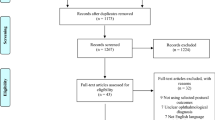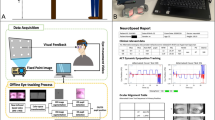Abstract
Aim
The purpose of the study was to examine the effect of eye re-alignment (after wearing prisms and after eye surgery) on postural stability in children with strabismus.
Methods
Nine children with strabismus (6–13 years old) participated in the study. A posturography platform (TechnoConcept) was used to examine posture in quiet stance at two distances: steady fixation of a target at near distance (40 cm) and at far distance (200 cm). Four different conditions were tested: with and without prisms before eye surgery, and twice after eye surgery.
Results
The surface of the CoP increased after wearing prisms (540 mm2 compared to the condition without prisms (462 mm2); in contrast, eye surgery reduced the surface of the CoP, leading to improved postural control (454 mm2 and 401 mm2, respectively, in the post 1 and post 2 surgery condition). Unlike normal children, strabismic children showed no improvement in postural control at near distance.
Conclusions
Binocular visual and motor changes affect body sway; adaptive mechanisms induced by eye re-alignment after surgery allow improved postural control. The absence of dependency on distance in postural stability in strabismic children could be due to their impaired depth perception and to the poor integrity of the visual signal required to control posture.


Similar content being viewed by others
References
Brandt T (2003) Vertigo. Its Multisensory Syndromes, 2nd edn. Springer, London
Bucci MP, Le TT, Wiener-Vacher S, Bremond-Gignac D, Bouet A, Kapoula Z (2009) Poor postural stability in children with vertigo and vergence abnormalities. Invest Ophthalmol Vis Sci 50:4678–84
Friedrich M, Grein HJ, Wicher C, Schuetze J, Mueller A, Lauenroth A, Hottenrott K, Schwesig R (2008) Influence of pathologic and simulated visual dysfunctions on the postural system. Exp Brain Res 186:305–14
Peterka RJ (2002) Sensorimotor integration in human postural control. J Neurophysiol 88:1097–118
Ravaioli E, Oie SK, Kiemel T, Chiari L, Jeka J (2005) Nonlinear postural control in response to visual translation. Exp Brain Res 160:450–9
Von Noorden GK, Campos EC (2006) Binocular Vision and Ocular Motility. Theory and Management of Strabismus, 6th edn. Mosby, St. Louis, MO
Odenrick P, Sandstedt P, Lennerstrand G (1984) Postural sway and gait of children with convergent strabismus. Dev Med Child Neurol 26:495–9
Matsuo T, Narita A, Senda M, Hasebe S, Ohtsuki H (2006) Body sway increases immediately after strabismus surgery. Acta Med Okayama 60:13–24
Legrand A, Bui-Quoc E, Wiener-Vacher S, Ribot J, Lebas N, Milleret C, Bucci MP (2011) Postural control in children with strabismus before and after surgery. Neurosciences Letters 501(2):96–101
Bucci MP, Kapoula Z, Eggert T, Garraud L (1997) Deficiency of adaptative control of binocular coordination of saccades in strabismus. Vis Res 37:2767–77
Bucci MP, Kapoula Z, Yang Q, Roussat B, Bremond-Gignac D (2002) Binocular coordination of saccades in strabismic children before and after surgery. Invest Ophthalmol Vis Sci 43:1040–7
Matsuo T, Yabuki A, Hasebe K, Shira YH, Imai S, Ohtsuki H (2010) Postural stability changes during the prism adaptation test in patients with intermittent and constant exotropia. Invest Ophthalmol Vis Sci 51:6341–7
Howard IP, Rogers BI (2002) Seeing in Depth. I. Porteous, Toronto, ON
Moutakis K, Stigmar G, Hall-Lindberg J (2004) Using the KM visual acuity chart for more reliable evaluation of amblyopia compared to the HVOT method. Acta Ophthalmol Scand 82:547–51
Vuillerme N, Chenu O, Pinsault N, Fleury A, Demongeot J, Payan Y (2008) Can a plantar pressure-based tongue-placed electrotactile biofeedback improve postural control under altered vestibular and neck proprioceptive conditions? Neuroscience 155:291–6
Geurts AC, Nienhuis B, Mulder TW (1993) Intrasubject variability of selected force-platform parameters in the quantification of postural control. Arch Phys Med Rehabil 74:1144–50
Kutschke PJ, Scott WE (2004) Prism adaptation in visually mature patients with esotropia of childhood onset. Ophthalmol 111:177–9
Ela-Dalman N, Velez G, Thacker N, Britt MT, Velez FG (2006) Maximum motor fusion combined with one-hour preoperative prism adaptation test in patients with acquired esotropia. J AAPOS 10:561–4
Kassem RR (2008) A pilot study of the value of prism adaptation in planning strabismus reoperations. J Pediatr Ophthalmol Strabismus 45:98–103
Repka MX, Connett JE, Scott WE, the Prism Adaptation Study Research Group (1996) The one-year surgical outcome after prism adaptation for the management of acquired esotropia. Ophthalmology 103:922–928
Ohtsuki H, Hasebe S, Kono R, Shiraga F (1999) Prognostic factors for successful surgical outcome with preoperative prism adaptation test in patients with superior oblique palsy. Acta Ophthalmol Scand 77:536–540
Steinbach MJ, Smith DR (1981) Spatial localization after strabismus surgery: evidence for inflow. Science 18; 213(4514):1407–1409
Brandt T, Paulus W, Straube A (1986) Vision and posture. In: Bles W, Brandt T (eds) Disorders of Posture. Elsevier Science Publishers, Amsterdam
Bles W, Kapteyn TS, Brandt T, Arnold F (1980) The mechanism of physiological height vertigo. II. Posturography. Acta Otolaryngol 89:534–540
Paulus W, Straube A, Krafczyk S, Brandt T (1989) Differential effects of retinal target displacement, changing size and changing disparity in the control of anterior/posterior and lateral body sway. Exp Brain Res 78:243–252
Paulus WM, Straube A, Brandt T (1984) Visual stabilization of posture. Physiological stimulus characteristics and clinical aspects. Brain 107:1143–1163
Guerraz M, Sakellari V, Burchill P, Bronstein AM (2000) Influence of motion parallax in the control of spontaneous body sway. Experimental Brain Research 131:244–252
Thompson AM, Nawrot M (1999) Abnormal depth perception from motion parallax in amblyopic observers. Vis Res 39:1407–1413
Acknowledgements
The authors thank the children who participated in the study, Florence Groffal for managing the children’s appointments, and Zofia Laubitz for correcting our English.
Author information
Authors and Affiliations
Corresponding author
Rights and permissions
About this article
Cite this article
Legrand, A., Bui-Quoc, E. & Bucci, M.P. Re-alignment of the eyes, with prisms and with eye surgery, affects postural stability differently in children with strabismus. Graefes Arch Clin Exp Ophthalmol 250, 849–855 (2012). https://doi.org/10.1007/s00417-011-1845-z
Received:
Revised:
Accepted:
Published:
Issue Date:
DOI: https://doi.org/10.1007/s00417-011-1845-z




